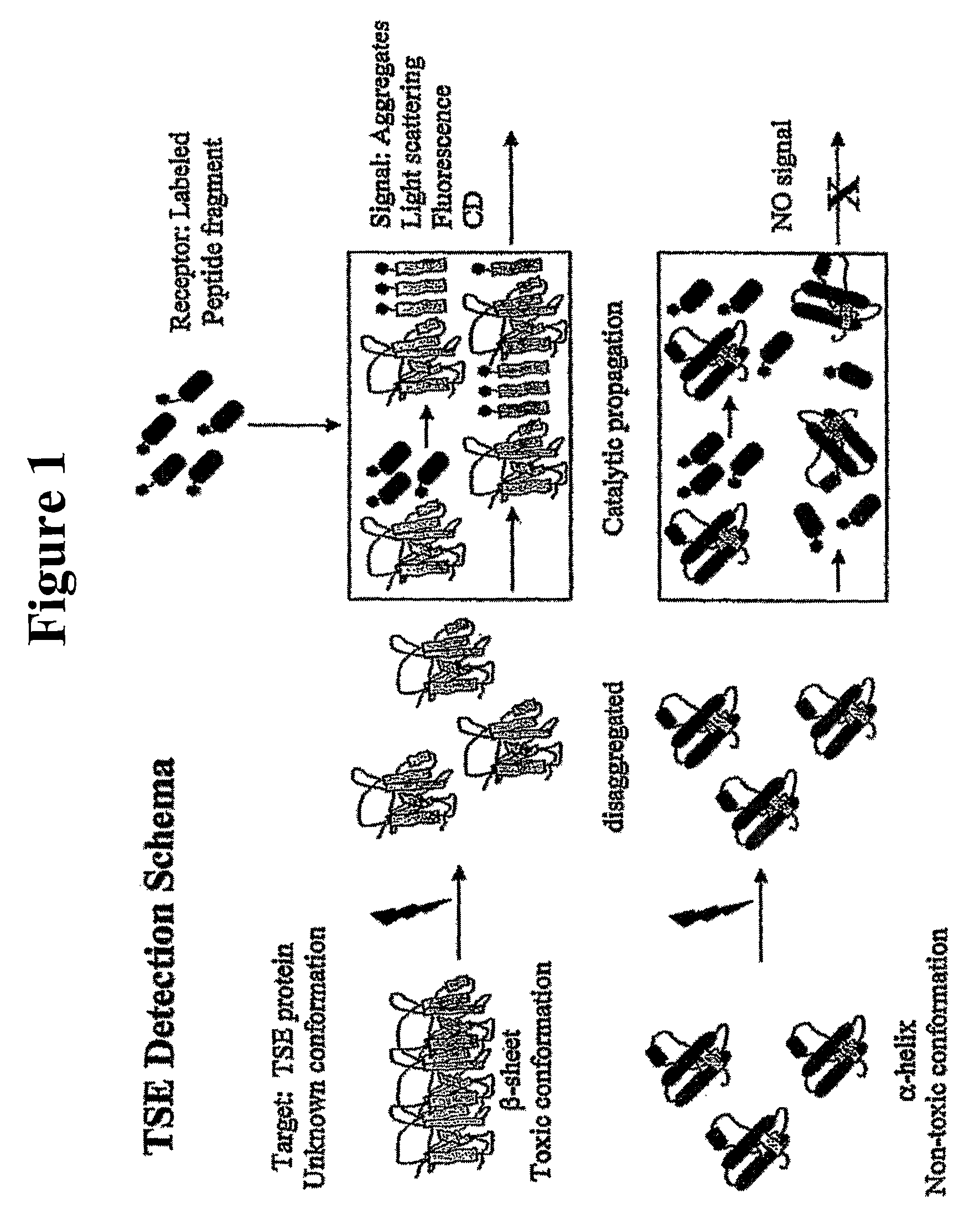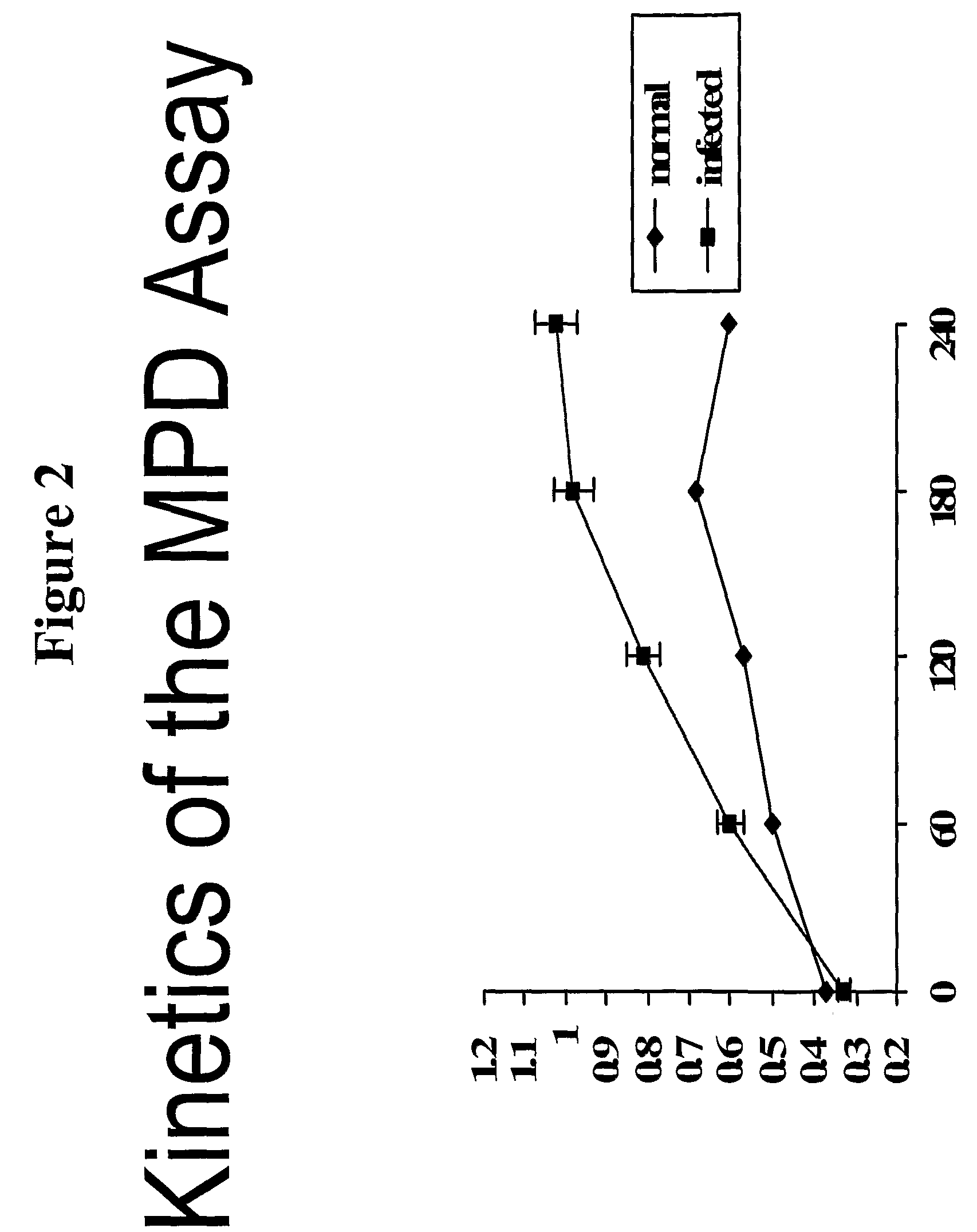Method for detecting misfolded proteins and prions
a protein and protein technology, applied in the field of protein detection in biological samples, can solve the problems of protein loss activity, abnormal behavior, formation of high molecular weight deposits or plaques within affected cells, etc., and achieve the effect of increasing detection sensitivity, superior sensitivity and effective detection
- Summary
- Abstract
- Description
- Claims
- Application Information
AI Technical Summary
Benefits of technology
Problems solved by technology
Method used
Image
Examples
example 1
Detection of Prion Protein in Biological Sample
[0091]A conformational propagation assay for prion protein in a murine brain sample was performed essentially as described in Published U.S. Patent Application 2005 / 0026265 A1, and as depicted in FIG. 1. The assay was performed using the murine-specific pallindromic 33-mer probe depicted below (SEQ. ID. NO. 49), labeled at both ends with a pyrene label. Other probes for human / hamster and sheep / bovine prions are presented below as well, and can be used for detection of prions in those species.
[0092]
H2N-VVAGAAAAGAVHKLNTKPKLKHVAGAAAAGAVV-COOH(murine sequence; SEQ. ID. NO. 53)H2N-VVAGAAAAGAMHKMNTKPKMKHMAGAAAAGAVV-COOH(human / hamster sequence; SEQ. ID. NO. 54)H2N-VVAGAAAAGAVHKMNTKPKMKHVAGAAAAGAVV-COOH(sheep / bovine sequence; SEQ. ID. NO. 55)
For improved labeling, the above sequences have been modified to contain an additional lysine (K) residue at the C-terminus (SEQ. ID. NOs. 56-58) to allow addition of a pyrene label.
[0093]
(SEQ. ID. NO. 56)H...
example 2
Demonstration of Kinetic Component of the Misfolded Protein Diagnostics (MPD) Assay Using Murine Brain Tissue
[0094]Murine brain tissue from Scrapie-infected and healthy animals was obtained and fractionated on a sucrose gradient. The MPD Assay of Example 1 was performed, using phosphotungstic acid as a precipitating reagent, followed by addition of the murine specific peptide probe. The mixture was allowed to react in Tris:TFE (50:50) mixture per the timecourse shown on the x-axis of FIG. 2. The results show suitable detection of prion protein in samples, which is above background levels for normal brain tissue.
example 3
Fractionation of Prion-Containing Sample According to the Present Invention
[0095]Sheep serum was obtained and mixed with sheep-specific peptide probe (see sequences above), and the mixture was incubated for a sufficient amount of time to permit association of the probe with any prion protein in the serum. The mixture was applied directly to a Sepharose 4B column, and fractions collected. The fractions were analyzed for fluorescence by exciting at 350 nm and scanning from 350-600 nm on a luminescent plate reader. The luminescence of each fraction from healthy and infected sera is depicted in FIG. 3. This data provides for visualization of elution of reactive fractions from the column. As can be seen, using the method of the present invention, not only can the infectious serum be distinguished from the healthy, it can occur in “real-time”. Because the peptide was incubated with the sample prior to fractionation, the assay for misfolded protein is performed during the fractionation.
PUM
| Property | Measurement | Unit |
|---|---|---|
| excitation wavelength | aaaaa | aaaaa |
| excitation wavelength | aaaaa | aaaaa |
| wavelength | aaaaa | aaaaa |
Abstract
Description
Claims
Application Information
 Login to View More
Login to View More - R&D
- Intellectual Property
- Life Sciences
- Materials
- Tech Scout
- Unparalleled Data Quality
- Higher Quality Content
- 60% Fewer Hallucinations
Browse by: Latest US Patents, China's latest patents, Technical Efficacy Thesaurus, Application Domain, Technology Topic, Popular Technical Reports.
© 2025 PatSnap. All rights reserved.Legal|Privacy policy|Modern Slavery Act Transparency Statement|Sitemap|About US| Contact US: help@patsnap.com



